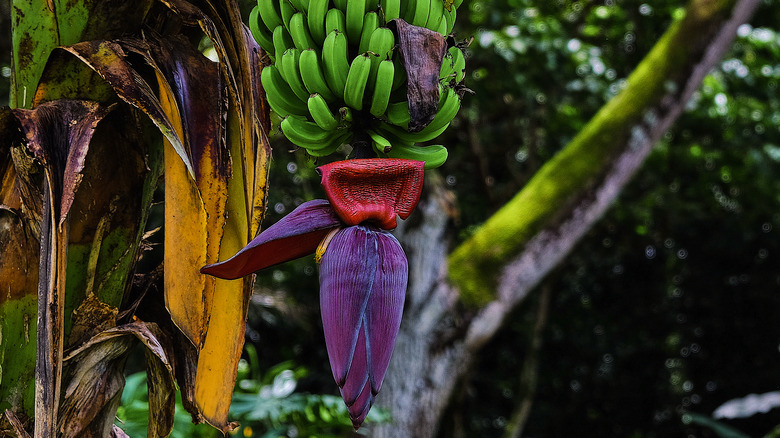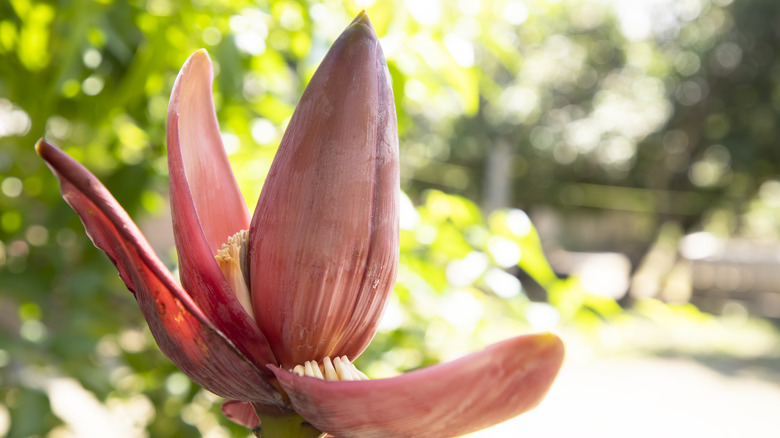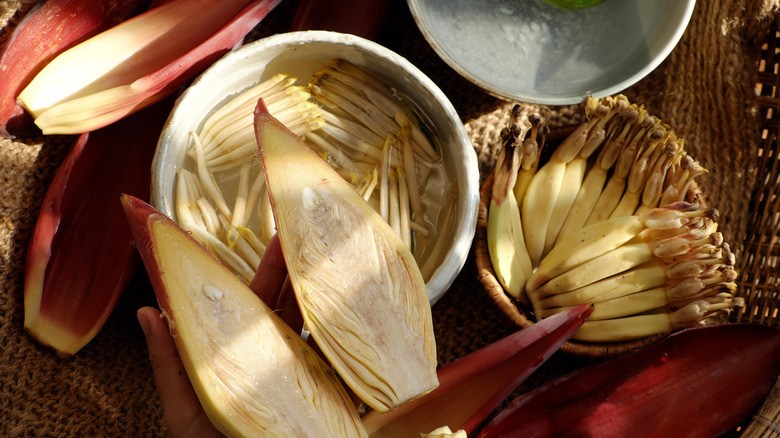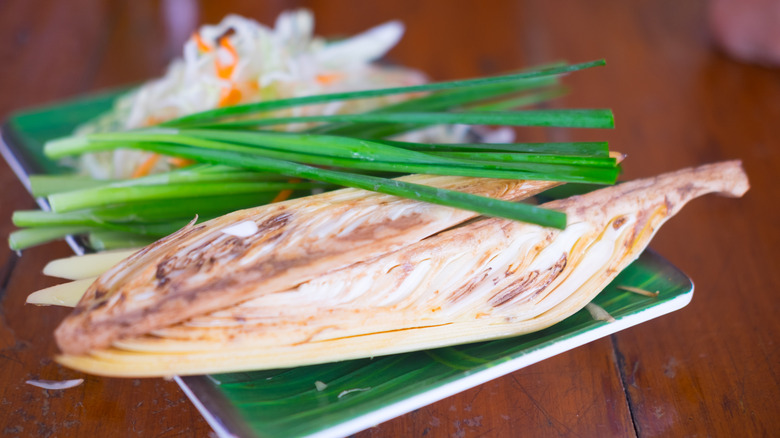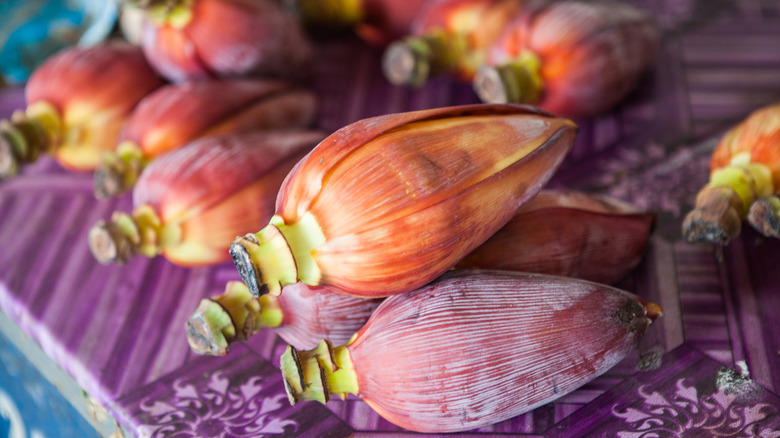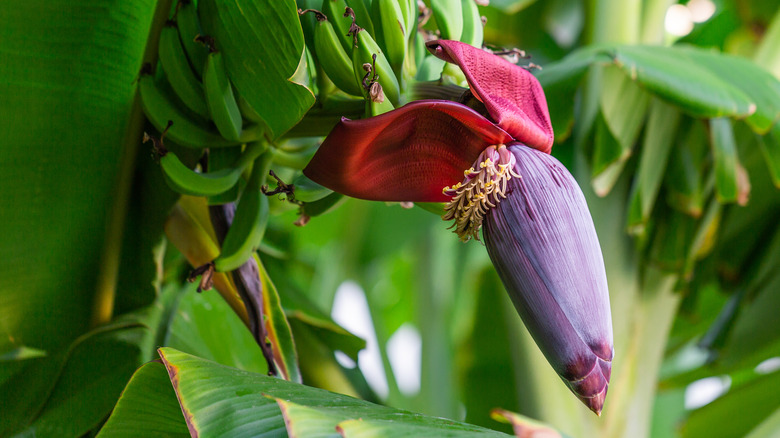What Do Banana Flowers Actually Taste Like?
What's your favorite fruit? Whether you prefer biting into crisp apples, enjoying juicy oranges, or slicing up bananas, there is more to love than just the fruit itself. Many fruiting trees produce edible flowers that often go overlooked. Apples, oranges, and more of your go-to healthy snacks have tasty blossoms that work great as garnishes or are turned into tea. However, the banana flower is different from many of the other fruits' flowers. While several fruit blossoms are small and dainty, the banana flower is large, sturdy, and surprisingly delicious when prepared correctly.
Banana flowers (musa acuminata), also called banana blossoms or a banana heart, are mainly enjoyed in South Asian cooking, where the plant is prevalent. However, whether you're looking for a great meat substitute to cook with or simply a fun appetizer at your next dinner party, it might be worth scouring your local farmers' markets for this unique and underrated food.
What are banana flowers
Banana flowers are easily recognizable by their purple, cone-shaped leaves. These flowers grow inside their leaves from the bottom of banana clusters in groups called hands. Each individual flower is considered a "finger." Here, the teardrop-shaped plant hangs waiting to be plucked off by the growers. Or, if left alone, each finger will eventually mature to become the banana fruit itself.
The thick exterior leaves are edible, but it's the soft flowering inside that's more desirable. When the dark purple leaves are pulled away, the thin white flowering fingers (which are protected by thinner, pinker leaves) are revealed.
At their largest, the entirety of these blossoms can weigh about half a kilogram, bringing light to why farmers feel they may need to remove some of these weightier ones. However, removing these flowers before they become fruit is great for more than just convenience. These plants are enjoyed both raw and cooked by many local peoples who know just how good they can be.
The wild banana plants, from which these flowers bloom, mostly grow in the tropical regions of South and Southeast Asia. It is said to have first originated in Malaysia before spreading to other nearby nations. And, they taste slightly different than you might expect.
What do banana flowers taste like?
For all the banana lovers out there, we're sorry to let you know that banana flowers do not share their fruits' quintessential sweet and tropical taste. However, there is a hint of that banana flavor present, especially in its scent. After all, banana flowers do eventually grow into this tasty fruit.
The exact taste of this plant is difficult to describe. It is slightly floral and a bit nutty. It can also be quite bitter if not prepared correctly or when consumed raw. These flowers are often compared to the taste of artichoke leaves or bamboo shoots. Overall, though, the taste is pretty mild, allowing it to absorb the flavors of whatever it is cooked with.
Texture-wise these plants are quite satisfying as well. They're delicate and soft when plucked from the plant, yet they can also offer a bit of firm crispness.
All these qualities make it a great ingredient to include in all kinds of dishes, from a vegetarian substitute to traditional stir-fry dishes.
How to cook with banana flowers
There are a number of ways to cook with a banana flower, but it's important to note that the waxy outer leaves are rarely eaten. Rather, they are a great accompaniment to dishes as a serving platter or garnish. The inner flowers, however, are very versatile, and their neutral taste makes them perfect for absorbing the flavors of whatever it's being cooked with.
The flowers can be eaten raw, but proper preparation is key to avoid bitterness. The sticky sap around the flowers is what contains this more off-putting flavor. Simply rinsing or soaking the flowers before use will take care of this issue. Chopping up the uncooked flower is great to add a bit of desirable texture to a salad. However, it's most often cooked up in stir-fries, soups, and other warm, savory dishes. Thailand's famed pad thai often features banana flowers and several Indian curries include the plant, as well. They may also be stuffed inside dumplings or made into fritters across the continent.
More recently, banana flowers have been discovered as an easy meat substitute. Specifically, its flakier texture makes it a great replacement for fish.
Now, having been inspired to make one of these delicious dishes, you'll likely need to figure out how to find banana flowers near you. And, it can be a bit tricky depending on where you live.
Where to buy banana flowers
If you happen to be visiting road-side stands in Southeast Asia or bustling food markets in India, it likely won't be too hard to spot a pile of banana flowers. However, for those on the hunt in North America, or any other part of the world that lacks tropical regions, it may be a bit harder to track down the plant.
If you're in a city, head to your local Asian market. You may be able to find some of the imported plants in the produce section. When selecting ideal banana flowers, make sure to feel the outer leaves. They should feel solid and compacted together, and they should still maintain their vibrant coloring. Loose, browning leaves are a sign the plant is past its prime, and these should be avoided.
You may also be able to find banana flowers in the canned section. Some big box stores, like Whole Foods and Walmart, sell canned banana blossoms in brine. Other than that, your best bet will be hunting around online for a canned or frozen version that can be shipped to your house.
Nutritional information about banana flowers
While it may be a pain to go on a banana flower hunt in your local city, the health benefits might just make the search worth it. This plant is wildly nutritious and has often been used in medicines across its native regions.
There are many health claims associated with banana flowers, including that eating them can prevent cancer, improve gut health, and decrease blood sugar levels. Most of these supposed benefits can be attributed to its high levels of certain antioxidants, like quercetin. This plant is also rich in fiber and contains a myriad of essential minerals, such as zinc, iron, calcium, magnesium, and more. Also, as a bonus, banana flowers have a minimal caloric content and no fat.
Traditional medicinal practices across South Asia has seen nearly all parts of the plant be put to use, from the leaves to the sap. It also can be turned into tea and enjoyed as a supplement.
However you opt to eat this delicious plant, you can feel confident that you're doing your body a favor by this relatively unknown superfood.
